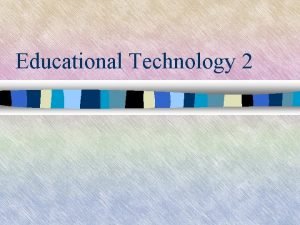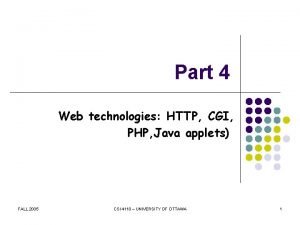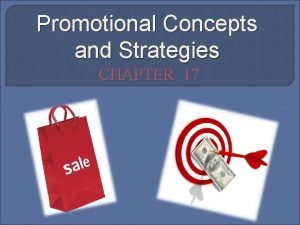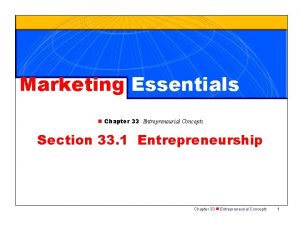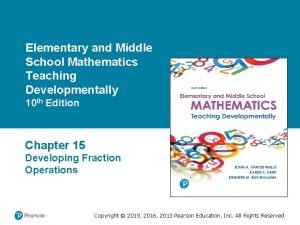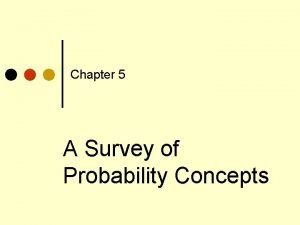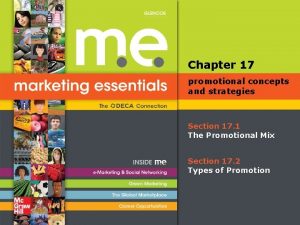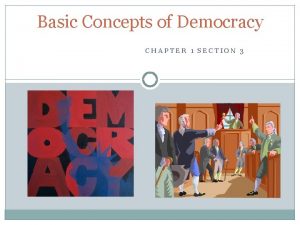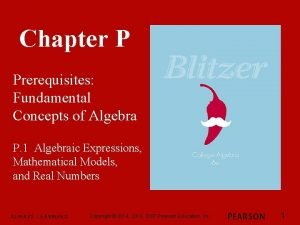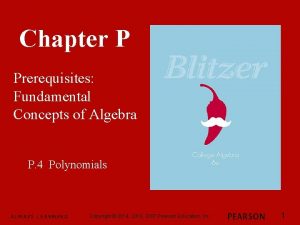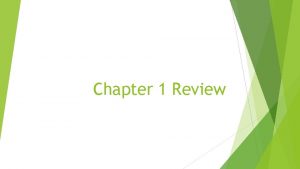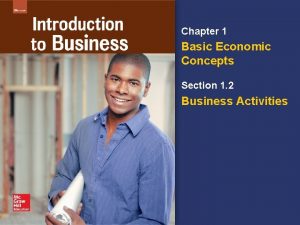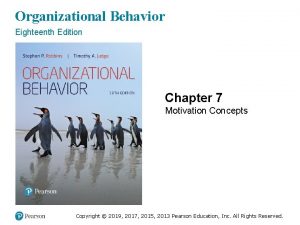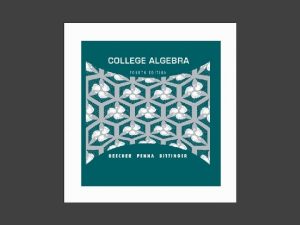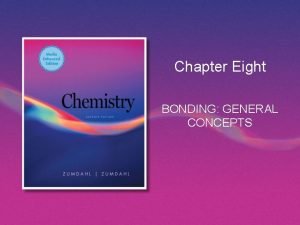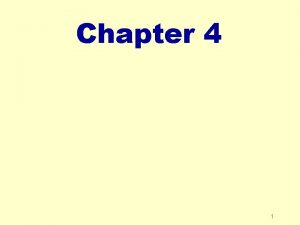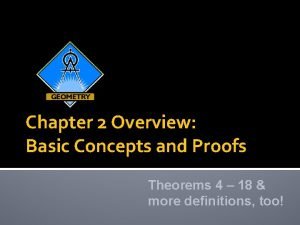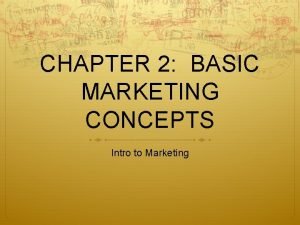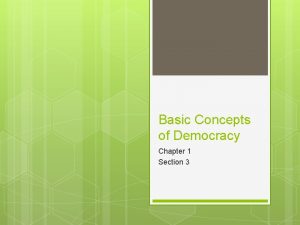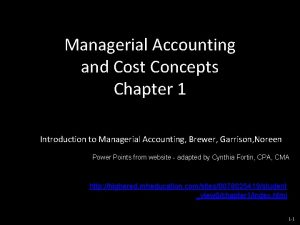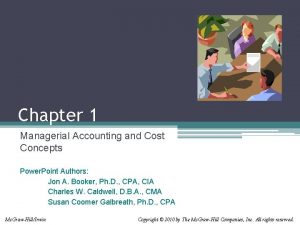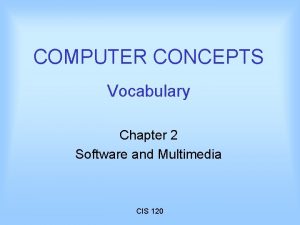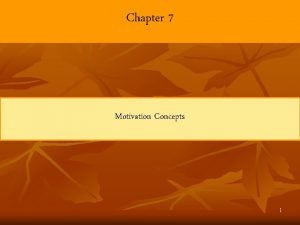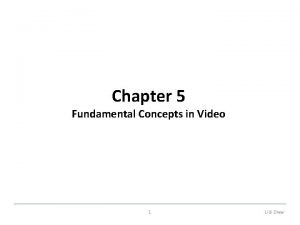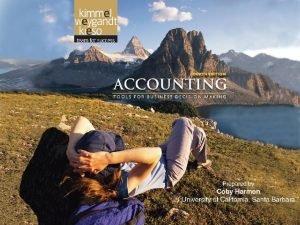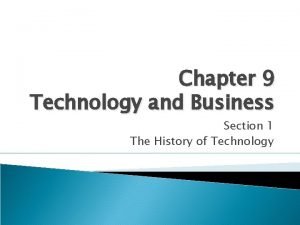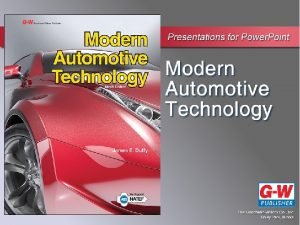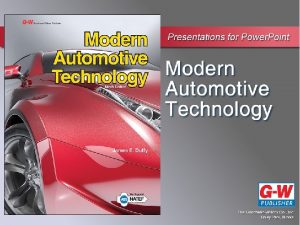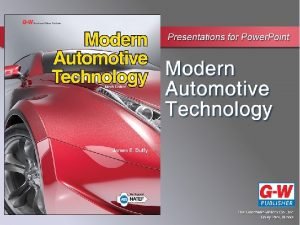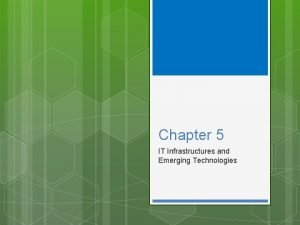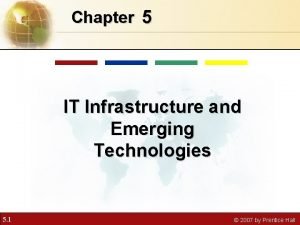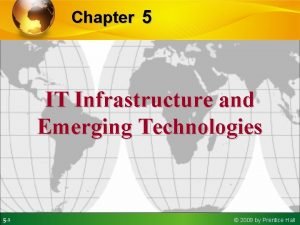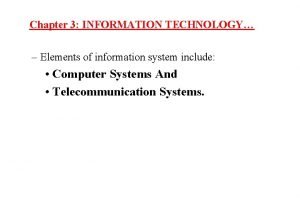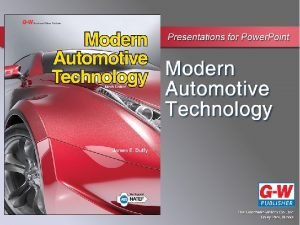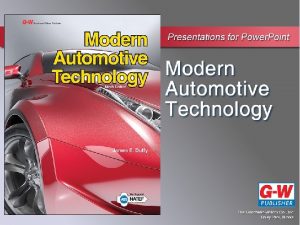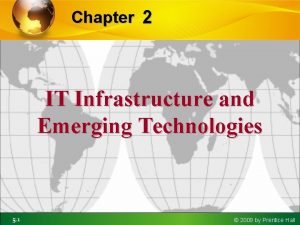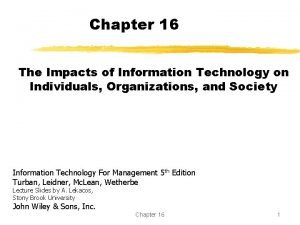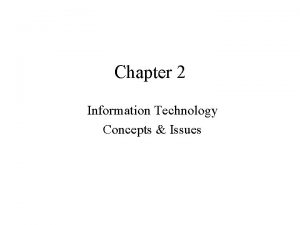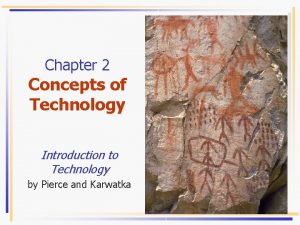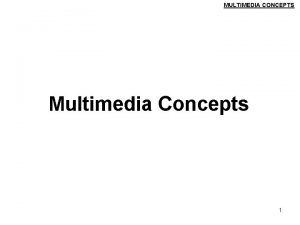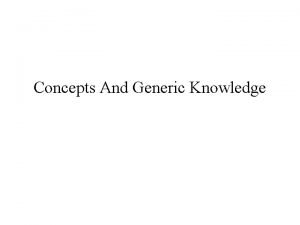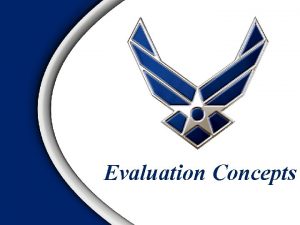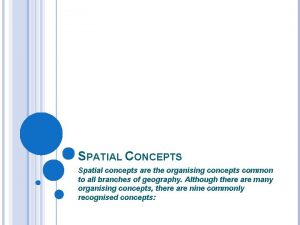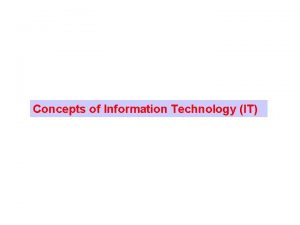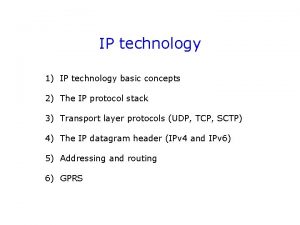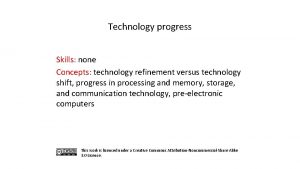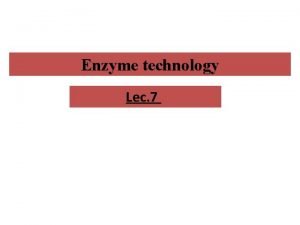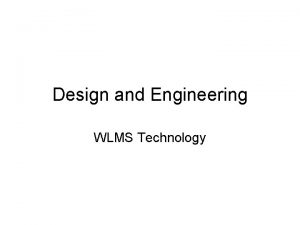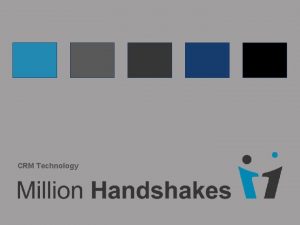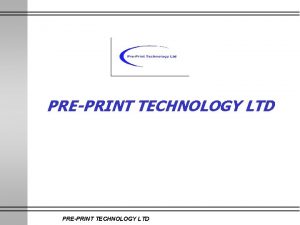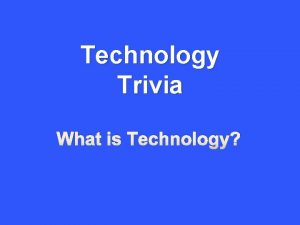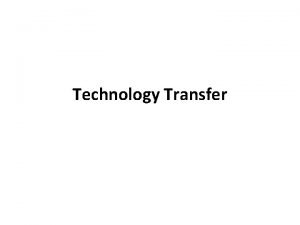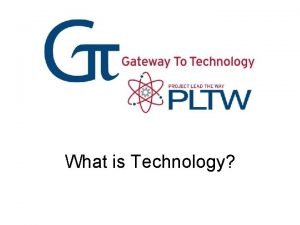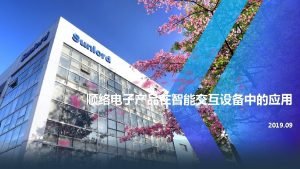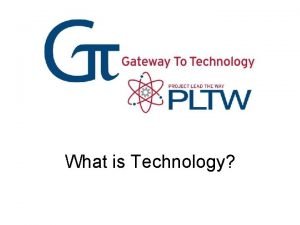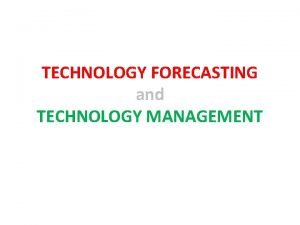Chapter 2 Concepts of Technology Chapter 2 Concepts












































- Slides: 44

Chapter 2 Concepts of Technology

Chapter 2 Concepts of Technology Section 2. 1 Technology Resources Section 2. 2 Technology Systems Section 2. 3 Developing a System or Product 2

Technology Resources 2. 1 Objectives Content Vocabulary § Identify the seven technology resources. § Explain how skills and creativity lead to new inventions. § Describe the six simple machines. § § § resource skill tool primary tool machine capital 3

Technology Resources 2. 1 Graphic Organizer Use this graphic organizer to organize and write down information as you study. 4

Technology Resources 2. 1 Get Started! Describe one piece of technology that has changed over time. 5

Technology Resources 2. 1 Technology Past and Present People of ancient times used their hands to form raw materials like stone into useful tools, such as choppers and scrapers. 6

Technology Resources 2. 1 Technology Past and Present The seven technology resources include: People Information Tools and machines Capital Time Materials Energy resource something that gives help or aid to a system 7

Technology Resources 2. 1 People and Technology Throughout history, people developed technology by creatively thinking of solutions to problems. People’s skills allow them to convert their ideas into real products, systems, and processes. skill an ability you develop when you combine knowledge and practice in order to perform an activity well 8

Technology Resources 2. 1 Information is important and needed for the advancement of knowledge, learning, scholarship, understanding, and wisdom. 9

Technology Resources 2. 1 Tools and Machines People use tools to complete their jobs. tool a device that increases our ability to do work 10

Technology Resources 2. 1 Primary Tools Primary tools are tools that increase a person’s ability to hold, cut, drill, bend, and hammer materials. primary tool a basic tool that is handheld and muscle powered 11

Technology Resources 2. 1 Machines Mechanical power systems use one or more of the following six simple machines: Wheel and axle Pulley Lever Inclined plane Wedge Screw machine a tool with a power system that takes advantage of certain scientific laws that make the tool work better 12

Technology Resources 2. 1 Machines Mechanical power systems use any one of the simple machines to change direction, speed, or force. 13

Technology Resources 2. 1 Capital and Technology Invention often takes the freedom of time to think, create, and capital to afford the materials involved. capital money, credit, or property 14

Technology Resources 2. 1 Capital and Technology Time affects the development of technology products. It takes time to create technology. Also, people are paid for the time they work when building products. 15

Technology Resources 2. 1 Materials and Technology Materials make up the products and processes of technology. Materials can be raw, processed, manufactured, or synthetic. 16

Technology Resources 2. 1 Energy and Technology Energy is the source of power that runs technological systems. The sources of energy are natural or synthetic. 17

Technology Systems 2. 2 Objectives Content Vocabulary § Explain systems and subsystems. § Discuss the difference between open- and closedloop systems. § Explain how systems relate to technology. § § § § system subsystem open-loop system input process output closed-loop system feedback 18

Technology Systems 2. 2 Graphic Organizer Use this graphic organizer to organize and write down information as you study. 19

Technology Systems 2. 2 Get Started! Describe systems you might have learned about in other classes. 20

Technology Systems 2. 2 Understanding Systems A system is an organized way of doing something. Systems include subsystems. For example, a jet engine is a subsystem of an airplane, a system made of parts that work together to complete a task subsystems smaller systems that exist within larger systems 21

Technology Systems 2. 2 Diagramming Systems Technologists often use diagrams to demonstrate their vision, so other can understand. 22

Technology Systems 2. 2 Open-Loop Systems Examples of open-loop systems include: Bathtubs Stoves Traffic lights open-loop system a system that has no way to measure or control its product 23

Technology Systems 2. 2 Open-Loop Systems Open-loop systems include three parts: Input Process Output input resources, ideas, and activities that determine what you need to accomplish something process conversion of ideas or activities into products by using machines and labor output what the system produces or achieves 24

Technology Systems 2. 2 Open-Loop Systems 25

Technology Systems 2. 2 Open-Loop Systems A closed-loop system is used for many types of systems: Fish tank water filter Motion detectors Traffic lights closed-loop system an open-loop system with an added feature that provides up-to-date information about an end product (output) 26

Technology Systems 2. 2 Closed-Loop Systems 27

Technology Systems 2. 2 Closed-Loop Systems Feedback “closes” the loop to make the system a stable closed-loop system. feedback the part of a closed-loop system that provide control or measurement of the product 28

Developing a System or Product 2. 3 Objectives Content Vocabulary § Discuss how requirements affect the development of products and systems. § Define criteria and constraints, optimization, and maintenance and control. § Identify tradeoffs and their effect on product development § Explain positive and negative effects of technology § § § criteria constraints optimization trade-off Beanstalk Principle 29

Developing a System or Product 2. 3 Graphic Organizer Use this graphic organizer to organize and write down information as you study. 30

Developing a System or Product 2. 3 Get Started! What is the difference of a want and a need? 31

Developing a System or Product 2. 3 Product Development When developing a product, a company makes sure it is safe, attractive, useful, and reliable. 32

Developing a System or Product 2. 3 Criteria and Constraints Product developers take criteria and constraints into consideration when determining a product’s uses. criteria requirements or specifications for a product to be successful constraints limits to a product’s design 33

Developing a System or Product 2. 3 Optimization and Trade-Offs Ideally, technologists would like to create the best product with the best materials available. This is known as optimization. However, trade-offs may be necessary as time and costs often dictate the final product. optimization a product designer creates a system, product, or process with the best tools available trade-off a compromise (often due to costs, time, and price) 34

Developing a System or Product 2. 3 Maintenance and Control Systems require upkeep and maintenance to keep them working. 35

Developing a System or Product 2. 3 Maintenance and Control The larger and more complex a system is, the harder it is to maintain. The Beanstalk Principle affects maintenance and control. Beanstalk Principle a basic rule that states systems, processes, and products should not grow beyond optimal or ideal size; if the principle is ignored, you can expect system failures 36

Developing a System or Product 2. 3 Impacts of Technology While technology often helps humanity, it can also hurt it. For example, technologies that pollute our atmosphere and causing global warming are of great concern to all life forms. 37

Developing a System or Product 2. 3 Technology Literacy Critical thinking is required to create an argument for or against something. You need to know how one thing can affect another (e. g. , energy/power versus manufacturing). 38

Chapter 2 Concepts of Technology Review Content Vocabulary Check 1. 2. 3. 4. 5. resource skill tool primary tool machine primary resource machine skill tool A Something that supplies A basic tool that is hand tool with a power system The combination of An instrument or apparatus that increases a held and muscle powered knowledge and practice that takes advantage of help or aid to a system; person’s ability to do work certain scientific laws that enables a person to can be a source of enable the tool to work information, capital, do something well supply, or support better 39

Chapter 2 Concepts of Technology Review Content Vocabulary Check 6. 7. 8. 9. 10. 11. capital system subsystem open-loop system input process open-loop subsystem process system capital inputsystem A group of parts that work Whatever resources that A system with no way of A system that is part of Accumulated wealth, The conversion of a together in an organized controlling or measuring another, larger system which may be money, are put into a system’s input into a useful product, or output way to complete a task credit, or property its product 40

Chapter 2 Concepts of Technology Review Content Vocabulary Check 12. 13. 14. 15. 16. output closed-loop system feedback criteria constraints closed-loop constraints feedback criteria outputsystem The part of a closed-loop What a system produces A system that has a way Limits to a product’s Requirements or of controlling or measuring system that provides specifications for a design control or measurement of product to be successful its product the product 41

Chapter 2 Concepts of Technology Review Content Vocabulary Check 17. optimization 18. trade-off 19. Beanstalk Principle Beanstalk optimization trade-off Principle A compromise (often due A basic rule that states A product designer creates a system, product, systems, processes, and to costs, time, and price) products should not grow or process with the best beyond optimal or ideal tools available size; if the principle is ignored, you can expect system failures 42

Chapter 2 Concepts of Technology Review Quick Check 1. Identify seven technology resources. 2. Name six simple machines. 3. Compare open- and closed-loop systems. 4. Define how requirements affect product development. 5. Explain how technology has positive and negative effects. Answers 1. people, information, tools and machines, capital, time materials, and energy 2. wheel and axle, pulley, lever, inclined plane, wedge, screw 3. An open-loop system includes input, process, and output, but no way of controlling the product. A closed-loop system adds feedback. 4. Products must be developed to be safe, attractive, useful, reliable, and affordable. 5. The effects cannot always be gauged at point of conception. To protect people and the environment, new technology must be monitored to determine negative effects. 43

End of Chapter 2 Concepts of Technology
 Basic concepts on integrating technology in instruction
Basic concepts on integrating technology in instruction Cgi concepts in web technology
Cgi concepts in web technology Chapter 17 promotional concepts and strategies answer key
Chapter 17 promotional concepts and strategies answer key Chapter 33 entrepreneurial concepts answers
Chapter 33 entrepreneurial concepts answers Chapter 15 developing fraction concepts
Chapter 15 developing fraction concepts A survey of probability concepts
A survey of probability concepts Promotional concepts
Promotional concepts Section 3 basic concepts of democracy
Section 3 basic concepts of democracy Chapter p prerequisites: fundamental concepts of algebra
Chapter p prerequisites: fundamental concepts of algebra Chapter p prerequisites fundamental concepts of algebra
Chapter p prerequisites fundamental concepts of algebra Chapter p prerequisites fundamental concepts of algebra
Chapter p prerequisites fundamental concepts of algebra Analyzing transactions
Analyzing transactions Reviewing concepts and vocabulary chapter 1
Reviewing concepts and vocabulary chapter 1 Chapter 1 basic economic concepts answers
Chapter 1 basic economic concepts answers Chapter 11 basic concepts street law
Chapter 11 basic concepts street law Chapter 7 motivation concepts
Chapter 7 motivation concepts Chapter r basic concepts of algebra answers
Chapter r basic concepts of algebra answers Chapter 8 bonding general concepts answers
Chapter 8 bonding general concepts answers Operating system concepts chapter 8 solutions
Operating system concepts chapter 8 solutions Operating system concepts chapter 5 solutions
Operating system concepts chapter 5 solutions Operating system concepts chapter 5 solutions
Operating system concepts chapter 5 solutions Chapter 4 accrual accounting concepts
Chapter 4 accrual accounting concepts Chapter 2 basic concepts and proofs answers
Chapter 2 basic concepts and proofs answers Chapter 2 basic marketing concepts
Chapter 2 basic marketing concepts Physics chapter 1 introduction and mathematical concepts
Physics chapter 1 introduction and mathematical concepts Basic concepts of democracy chapter 1 section 3
Basic concepts of democracy chapter 1 section 3 General multiplication rule
General multiplication rule Relevant range managerial accounting
Relevant range managerial accounting Chapter 1 managerial accounting and cost concepts
Chapter 1 managerial accounting and cost concepts Chapter concepts vocabulary
Chapter concepts vocabulary Motivation to learn an overview of contemporary theories
Motivation to learn an overview of contemporary theories Secam stands for
Secam stands for Accrual accounting principles
Accrual accounting principles What is the difference between e-workforce and e-commerce?
What is the difference between e-workforce and e-commerce? Brake system diagnosis and repair
Brake system diagnosis and repair Chapter 80 brake system technology answers
Chapter 80 brake system technology answers Suspension system
Suspension system Mainframe and minicomputer era
Mainframe and minicomputer era Emerging technology chapter 5
Emerging technology chapter 5 Emerging technology chapter 5
Emerging technology chapter 5 Information technology chapter 3
Information technology chapter 3 Chapter 29 12 volt and hv battery service
Chapter 29 12 volt and hv battery service Chapter 26 hybrid drive technology
Chapter 26 hybrid drive technology Chapter 5 it infrastructure and emerging technologies
Chapter 5 it infrastructure and emerging technologies Chapter 16 the impact of technology
Chapter 16 the impact of technology
